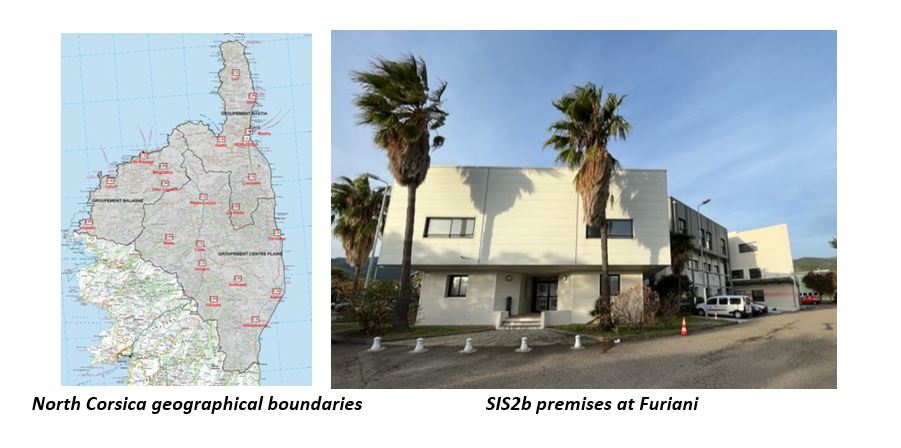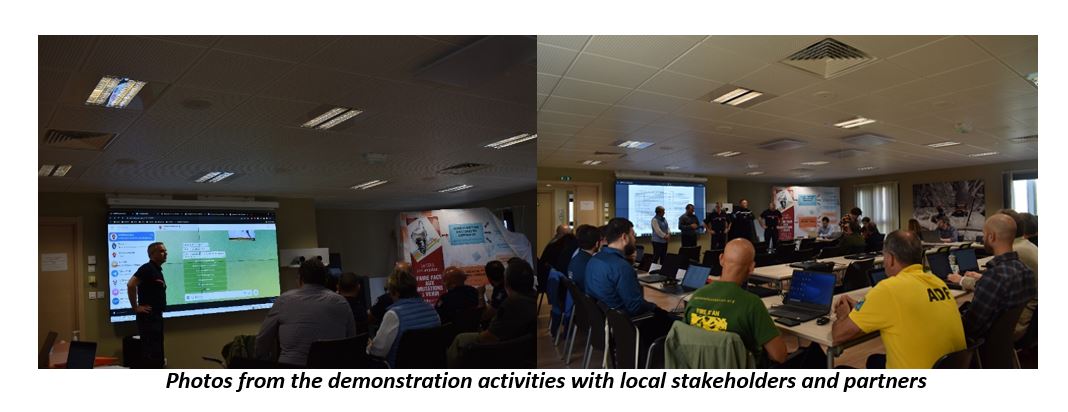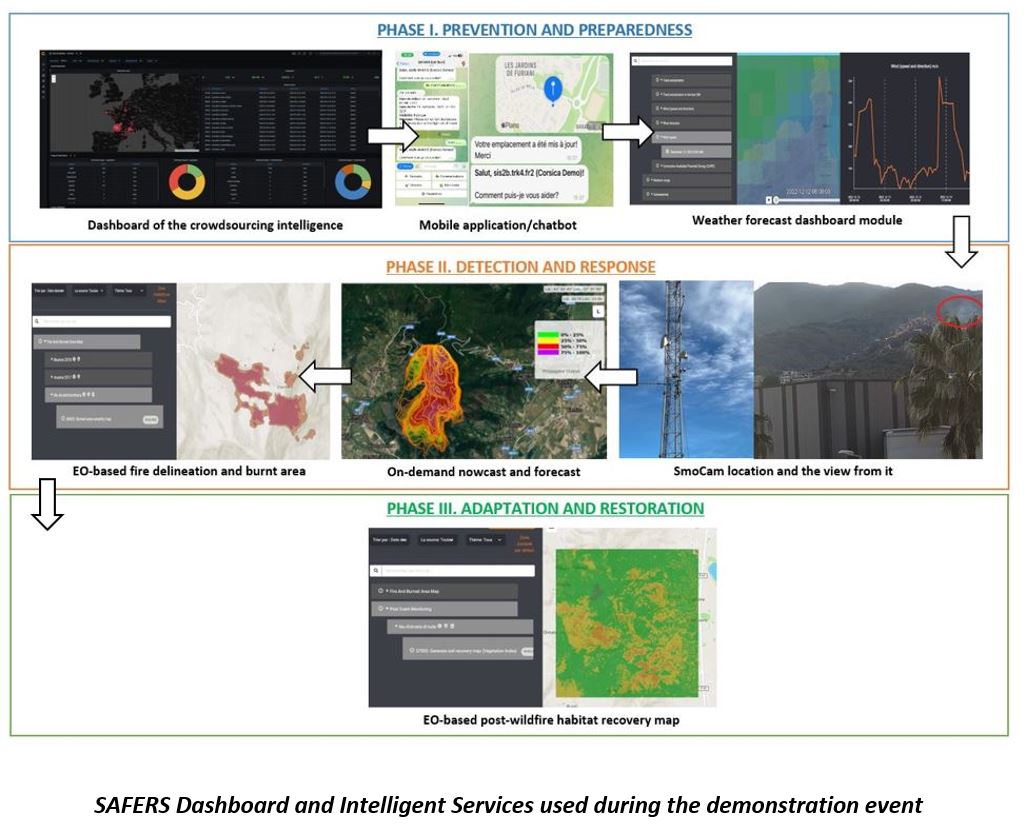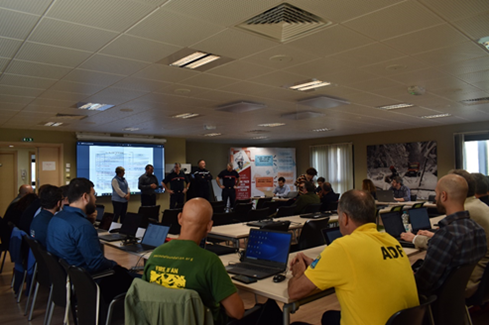Where was the demonstration implemented?
To test and evaluate SAEFRS platform and Intelligent Services (IS) that were released in a beta version, the first demonstration and training activities were performed on October 19th, 2022, in Corsica (France), and more precisely, at the premises of the Fire and Rescue Service of Haute-Corse (SIS2B) that organized the event.
With a team composed of 1,300 firefighters, SIS2B protects a population varying from 161,000 to approximately 400,000 people during the summer. SIS2B analyses and monitors more than 450,000 hectares of highly flammable forest and vegetation, with around 1,500 hectares of forest burned yearly since 2003. The structure is active in all sectors connected to civil defense and provides emergency rescue (road, sea and mountain rescue, etc.) and urban firefighting services.
The island of Corsica is prone to many disasters (e.g., forest fires, floods, flash floods and landslides). Consequently, the fire department has a significant experience as a first responder. The SAFERS demo took place near the municipality of Biguglia, which had been most impacted by the Olmeta di Tuda fire in 2017, that was selected as the reference scenario of the demo.

How did the demonstration go?
The beta version of the Intelligent Services was tested in a controlled but realistic environment with data and information from recent forest fire events well-known by local stakeholders. Besides SAFERS partners, the event involved technical entities, first responders, local authorities and citizens.
During the first phase of Prevention and Preparedness, the Crowdsourcing intelligence for improved EO mapping was used to perform real-time information extraction from Twitter. The service is operational 24/7 and its ability to retrieve information was tested in two ways: i/ by browsing recent real events from the 2022 fire season to assess the quantity and quality of the collected Tweets and ii/ by creating tweets during the demonstration event to verify the ability to retrieve information in real time. The dashboard visualises the worldwide list of detected events in the selected temporal interval after selecting the French language and the forest fire hazard.

During the same phase, the functionalities and capabilities of the Chatbot via the Telegram application were presented to the participants. The tool was tested on the field by assigning different tasks: share live positioning, change operational status and activity, take in charge and complete a mission, send situational updates via the reporting system.
The Sub-seasonal weather forecast and operational early warnings were also employed to compare the level of risk in SAFERS weather and hazard maps with those provided by Météo France during the summer season. Each weather forecast variable (e.g. temperature, wind speed, wind direction, relative humidity) was tested using both the spatial and the temporal visualization. The results show that SAFERS meteorological forecasting products are a good complementary data source to define the level of fire risk and thus, adapt the operational response throughout the year.
The Smoke and fire detection systems were tested during the second phase of Detection and Response using a smoke bomb. The SmoCam has been installed on a pole in the infrastructures of the SIS2B headquarters. It is powered electrically and gets the connectivity through a 4G cellular connection. The SmoCam has managed to detect the smoke simulating a fire start and created the alert on the SAFERS’s dashboard. The field team was then asked to confirm the start of the fire. This action was performed using the reporting capability of the Chatbot and eventually, a fire event was created in the SAFERS’s dashboard.

In the next step, the service of On-demand nowcast and forecast was used to predict the fire behaviour and spread, and to plan the actions (evacuations/attack strategies) in the response phase. The participants were provided with laptops to use the SAFERS dashboard to create simulations of a reference fire of interest and the system handled very well concurrent requests. In order to check how long it takes to run and how accurate the burnt delineation is, the EO-based fire delineation and burnt area was tested. The participants used SAFERS dashboard to create burned area maps by choosing a reference fire of interest.
Finally, the Adaptation and Restoration phase took place using the Earth Observation-based post-wildfire habitat recovery service. Maps to evaluate the vegetation recovery and the impact of the fire on the vegetation regrowth were requested and the participants were given the possibility to use the dashboard to create relevant maps while choosing a reference fire of interest.
What are the main feedbacks?
The interactions recorded during the demo and the training session were good thanks to the active participation of during the entire event. The demonstration allowed to test in a relevant environment the Dashboard of SAFERS and its IS while engaging with several end-users in Corsica and abroad, namely Jorge GOMES from VOST (Portugal), Pere REBULL from Forest Defence Volunteers in Catalonia (Spain) and Dario GAUS from Rijeka Fire brigade (Croatia).
Overall, strong interest was shown for the weather data and the detection of fire by the in-situ camera with the possibility of duplicating this system on multiple parts of the territory. All Chatbot functionalities have received positive feedback despite the problems encountered by the firefighters in the field. Besides, the fire propagation simulator was very appreciated by the firefighters that attended the demonstration. Additionally, the burned area module as well as the information retrieval tool on social networks were also very welcome.
The event revealed a few gaps that will be tackled in future demonstration events. First, the presentation of the services must be simplified in order to avoid overlapping. Second, in-field logistic activities must be planned carefully as they can be time-consuming during the demonstration. Finally, the staff shall be trained on how to use the Chatbot before the demonstration.
We recall that this event is the first out of the four demos of the project. The second demonstration has been performed in Torino (Italy) in February 2023, whereas the other two will be executed in Spain and Greece in the late 2023.

